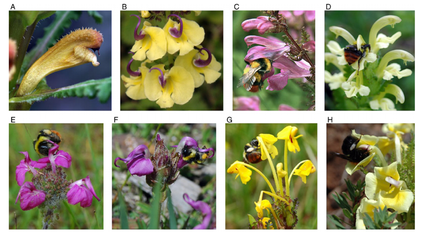|
Written by: Arielle Arsenault-Benoit (PhD student, Fritz lab) Dr. Deren Eaton, Assistant Professor at Columbia University, has broad interests in the evolution of plant morphology and diversification. In addition to his field and laboratory research, Dr. Eaton has a developed ipyrad, a software platform and toolkit to aid scientists in the analysis of genomic data in an effort to make analysis of genomic datasets more accessible and reproducible. The era of sequencing and genomic analysis is changing the way we think about ecology and evolution. By generating large datasets that span the genome, researchers can explore changes in lineages over space and time, and witness evidence of gene flow between populations, historical genetic mixing, or isolation events using statistical modeling approaches.  Figure 1 Examples of the floral diversity and pollination strategies of Pedicularis spp. in Hengduan Mountain Region, China. From Eaton et al. 2012. Figure 1 Examples of the floral diversity and pollination strategies of Pedicularis spp. in Hengduan Mountain Region, China. From Eaton et al. 2012. The Pedicularis spp. plant community in the Hengduan Mountains of China is a particularly interesting system for studying these genomic events. This region is a temperate biodiversity hotspot; of the 600 species worldwide, there are around 300 local species of Pedicularis that demonstrate vast floral diversity several are unique to the region1 (Figure 1). Many of these species co-occur on the landscape, flower at the same time, and use the same pollinators, creating potential for pollen transfer between species. In plants, cross-pollination can result in hybrid offspring, but this does not occur in Pedicularis1. Because non-conspecific pollen can compete with conspecific pollen when it reaches the female organs of a flower, natural selection can lead to adaptations to reduce the chances of interspecific pollination, increasing the plants’ reproductive success.  Figure 2 Examples of "horned beaks" on flowers, that force pollinators to enter flowers in specific orientations. Image courtesy of D. Eaton. Figure 2 Examples of "horned beaks" on flowers, that force pollinators to enter flowers in specific orientations. Image courtesy of D. Eaton. Unlike animals, plants cannot employ avoidance or migration behaviors to deal with competition, plus flowring plants may have obligatory relationships with their pollinators for reproduction. Therefore, they must employ different strategies to mitigate interactions with species that fill similar ecological niches- the specific habitat needs and conditions that an organism requires to fill a role in the ecosystem. In Pedicularis, some populations develop long tubes derived from fused petals (Figure 3), to extend the distance pollen needs to travel for fertilization (Figure 3). This helps to avoid interspecific pollination. Others develop a “horned beak” structure (Figure 2) on the flower so pollinators are forced into a particular orientation, ensuring pollen will be isolated to one section of the body and carried to the right part of the corresponding female flower. Dr. Eaton and colleagues use a suite of data analysis and modeling tools to see how these types of strategies manifest across mixed communities of Pedicularis flowers, using P. cranolopha as a focal species.  Figure 3 Populations of P. cranolopha that are geographically close look very different. White lines show the different corolla tube lengths between two geographically close populations. Image courtesy of D. Eaton. Figure 3 Populations of P. cranolopha that are geographically close look very different. White lines show the different corolla tube lengths between two geographically close populations. Image courtesy of D. Eaton. Pedicularis cranolopha is common in this region and demonstrates a variety of floral traits across populations. Dr. Eaton studied how the other Pedicularis species in a community can influence the size and shape of a population of flowers. If many plants in the same area have the same characteristics and flower at the same time, it increases the chances that competition will occur. Instead, selective forces cause divergence among the species in a process called character displacement2. Through a genetic analysis, Dr. Eaton found that populations of P. cranolopha group by geography, meaning those that are nearest by distance are the most genetically related. However, close relatives do not necessarily look similar (Figure 3), which is unusual in ecological systems. Populations of P. cranolopha were variable enough to develop flowers that look dissimilar from other species in their specific communities, so that their shapes and sizes are unique among the flowers they are close to on the landscape. Theoretically, this reduces the risk of interspecific pollination and increases reproductive success. Along with local effects, differences in flower shape could have consequences for the species as a whole, because populations within the species can get more and more genetically isolated. To support this finding, Dr. Eaton performed crosses between tall and small flowers in a field experiment. He discovered that fast-growing pollen from taller flowers can create more offspring because it can more quickly reach the female reproductive organ of the plant. This suggests a reproductive advantage toward longer flowers and faster pollen. Over time, as the morphology of P. cranolopha diverges between populations within the species, they can become less and less reproductively compatible. This model suggests that competition between species in an ecological community can influence interactions within as species due to population-level differences -as demonstrated by P. cranolopha. Additionally, a lack of hybridization within this system reinforces the genetic divergence between species. The phenomena that Dr. Eaton described could be partially responsible for the high rates of speciation and development of novel species in this region, and offer insights into the evolutionary history of flowering plants in this biodiversity hotspot.
References:
Comments are closed.
|
Categories
All
Archives
June 2024
|
Department of Entomology
University of Maryland
4112 Plant Sciences Building
College Park, MD 20742-4454
USA
Telephone: 301.405.3911
Fax: 301.314.9290
University of Maryland
4112 Plant Sciences Building
College Park, MD 20742-4454
USA
Telephone: 301.405.3911
Fax: 301.314.9290

 RSS Feed
RSS Feed




